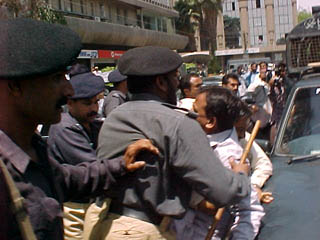Source(Google.com.pk)














Karachi Time Biography
After sending a couple of exploratory missions to the area, the British East India Company conquered the town on February 3, 1839. The town was later annexed to the British Indian Empire when Sindh was conquered by Charles James Napier in Battle of Miani on February 17, 1843. Karachi was made the capital of Sindh in the 1840s. On Napier's departure it was added along with the rest of Sindh to the Bombay Presidency, a move that caused considerable resentment among the native Sindhis. The British realised the importance of the city as a military cantonment and as a port for exporting the produce of the Indus River basin, and rapidly developed its harbour for shipping. The foundations of a city municipal government were laid down and infrastructure development was undertaken. New businesses started opening up and the population of the town began rising rapidly.
The arrival of troops of the Kumpany Bahadur in 1839 spawned the foundation of the new section, the military cantonment. The cantonment formed the basis of the 'white' city where the Indians were not allowed free access. The 'white' town was modeled after English industrial parent-cities where work and residential spaces were separated, as were residential from recreational places.
Karachi was divided into two major poles. The 'black' town in the northwest, now enlarged to accommodate the burgeoning Indian mercantile population, comprised the Old Town, Napier Market and Bunder, while the 'white' town in the southeast comprised the Staff lines, Frere Hall, Masonic lodge, Sindh Club, Governor House and the Collectors Kutchery [Law Court] (pron.: /kəˈtʃɛri/)[citation needed] located in the Civil Lines Quarter. Saddar bazaar area and Empress Market were used by the 'white' population, while the Serai Quarter served the needs of the 'black' town.
The village was later annexed to the British Indian Empire when the Sindh was conquered by Charles Napier in 1843. The capital of Sindh was shifted from Hyderabad to Karachi in the 1840s. This led to a turning point in the city's history. In 1847, on Napier's departure the entire Sindh was added to the Bombay Presidency. The post of the governor was abolished and that of the Chief Commissioner in Sindh established.
The British realized its importance as a military cantonment and a port for the produce of the Indus basin, and rapidly developed its harbor for shipping. The foundation of a city municipal committee was laid down by the Commissioner in Sinde, Bartle Frere and infrastructure development was undertaken. Consequently, new businesses started opening up and the population of the town started rising rapidly. Karachi quickly turned into a city, making true the famous quote by Napier who is known to have said: Would that I could come again to see you in your grandeur!
In 1857, the Indian Mutiny broke out in the subcontinent and the 21st Native Infantry stationed in Karachi declared allegiance to rebels, joining their cause on 10 September 1857. Nevertheless, the British were able to quickly reassert control over Karachi and defeat the uprising. Karachi was known as Khurachee Scinde (i.e. Karachi, Sindh) during the early British colonial rule.
Karachi Time

Karachi Time

Karachi Time

Karachi Time

Karachi Time

Karachi Time

Karachi Time

Karachi Time

Karachi Time

Karachi Time

Karachi Time

Karachi Time

Karachi Time

Karachi Time

Karachi Time
No comments:
Post a Comment